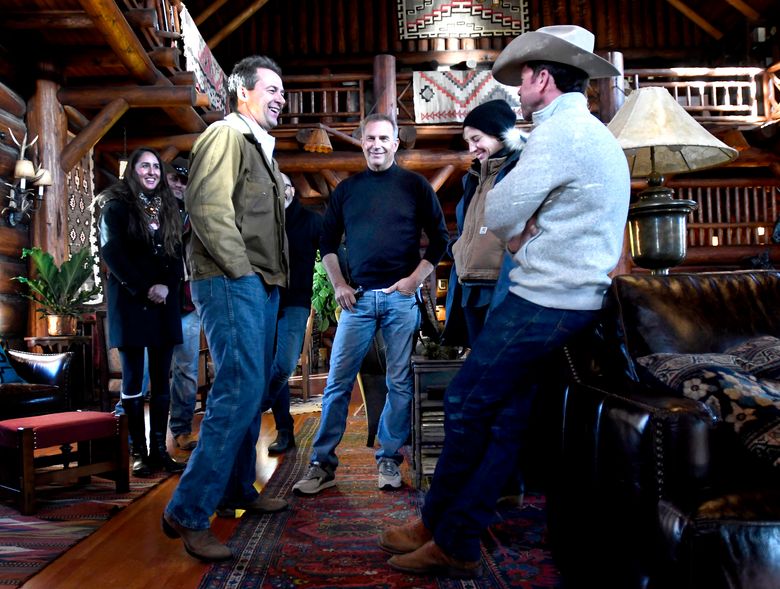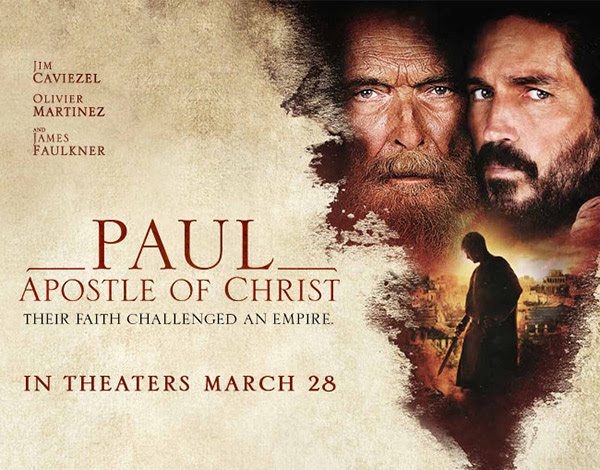https://www.seattletimes.com/nation-world/montana-governor-visits-set-of-yellowstone-tv-show/December 15, 2017

In this Dec. 7, 2017 photo, Montana Gov. Steve Bullock, foreground from left, appears with actor Kevin Costner, production designer Ruth De Jong and writer-director Taylor Sheridan in the lodge at the Chief Joseph Ranch during a visit to the set of the television series “Yellowstone” in Darby, Mont. The series is set for release in June. (Kurt Wilson/The Missoulian via AP)
HAMILTON, Mont. (AP) — Actor Kevin Costner welcomed Gov. Steve Bullock last week to the set of the new cable TV series “Yellowstone,” much of which is being shot at the Chief Joseph Ranch.
In the main living room of the lodge, decorated for the set with historic Navajo rugs hanging from the balconies and Remington bronzes on the tables, Costner and Bullock, along with writer/director Taylor Sheridan, discussed the pros and cons of filming in Montana.
Costner, looking relaxed in blue jeans and a dark sweater, said filming “Dances with Wolves” in South Dakota and “Field of Dreams” in Iowa changed the way those states are perceived. He called the new series “a postcard for Montana.”
“What a cool state to be the governor,” Costner said. “If something like ‘Yellowstone’ has a way of highlighting, being somewhat of a dramatic love letter to your state, we’ll be successful. The writing for it is superior.”
“But how’s the acting?” Bullock replied with a grin.
“Well, I’m being sent home right now,” Costner joked. “Actually, my community is on fire. But I do think something like ‘Yellowstone’ can change people, making it so they want to go here.”
Costner has a home outside of Santa Barbara, California, where the Thomas fire has charred more than 96,000 acres and two new fires broke out last week.
Joking aside, both Costner and Sheridan noted the economic boost “Yellowstone” is bringing to the Bitterroot Valley as well as Montana overall. The Montana Department of Commerce estimates the production has paid about $100,000 in labor, plus another $1.45 million for lodging, supplies, props, location fees and other expenses — including $25,000 for filming scenes in the Capitol.
“We spent $500,000 on hotels and car rentals,” said Perri Eppie, the publicity coordinator for “Yellowstone.” ”We’ve even stolen a few of your people and brought them to Utah,” where some interior shots are being filmed.
They’ve hired at least 63 people as drivers, technicians and production assistants, and an untold number of laborers to build fences, redo the corrals and arenas, and become extras for filming.
One company they hired was Rocky Mountain Homes in Hamilton, to add a front porch to the 100-year-old log home with river rock accents, because Sheridan decided he wanted the main entrance to be on the north side of the house. The company had to dig a large trench 6 feet down for the foundation, then build the deck.
“We asked them how long they thought it would take, and they said four months when I first asked,” said Ruth DeJong, the production designer. “I said ‘That’s not how we operate’ and they had it done in nine days. They were amazing.”
Last Thursday, the grounds were buzzing with activity as Eppie took members of the press and state officials on a tour of the filming site. ATVs ferried people and equipment around, while riders put horses through their paces.
According to a press release, “Yellowstone” chronicles the Dutton family, led by John Dutton (played by Costner) who controls the largest contiguous cattle ranch in the United States.
“Amid shifting alliances, open wounds, and hard-earned respect, the ranch is in constant conflict with those it borders — an expanding town, an Indian reservation, and America’s first national park. Far from media scrutiny, it’s a violent world of poisoned drinking water and unsolved murders. Yellowstone is an intense study of the modern West rife with land developers, energy speculators, assorted politicians, estranged family, and tribal players. Within this pentagon of interests, land lust is insatiable and love is weaponized.”
“We had a real bear chasing some characters — they ended up roping him,” Eppie said. “We also had six wolves out here” as part of the show.
Sheridan, who is a Wyoming native and perhaps best known for the recently released movie “Wind River, said he came up with the idea for “Yellowstone” and started writing it in Livingston in 2013. DeJong was looking for a site to shoot it in the Paradise Valley when she stumbled upon the Chief Joseph Ranch.
“I wrote a show where I wanted to be, and that wasn’t in California, but in Montana,” Sheridan said. “So I came up with a story line I thought was relevant.
“I could have shot this anywhere else, but I couldn’t find this anywhere else. . I decided to make a financial sacrifice to come here.”
The solitude and scenery was part of that incentive, but the lack of tax credits provided in other states, as well as the remoteness of the location, was a challenge. Sheridan said he’s willing to testify before the Montana Legislature about the power of tax incentives for filmmakers.
“I took a funding hit to come to the state for this, so anything I can do to sweeten the pot would be great. But you’re stuck with me now,” Sheridan said, grinning. “But for the next one, and the next one .”
“Yellowstone” will air on the Paramount Network, which will replace the cable channel Spike in January. The show, which has filmed off and on in Darby, Helena, the Crow Reservation and Utah since August, will return to the Bitterroot in March to shoot some final scenes before airing this summer.
Depending on reactions to the show, they just might be back for a second season.
“It’s special to be here and do what we do,” DeJong said.
___
Information from: Ravalli Republic , http://www.ravallirepublic.com

In this Dec. 7, 2017 photo, Montana Gov. Steve Bullock, foreground from left, appears with actor Kevin Costner, production designer Ruth De Jong and writer-director Taylor Sheridan in the lodge at the Chief Joseph Ranch during a visit to the set of the television series “Yellowstone” in Darby, Mont. The series is set for release in June. (Kurt Wilson/The Missoulian via AP)
HAMILTON, Mont. (AP) — Actor Kevin Costner welcomed Gov. Steve Bullock last week to the set of the new cable TV series “Yellowstone,” much of which is being shot at the Chief Joseph Ranch.
In the main living room of the lodge, decorated for the set with historic Navajo rugs hanging from the balconies and Remington bronzes on the tables, Costner and Bullock, along with writer/director Taylor Sheridan, discussed the pros and cons of filming in Montana.
Costner, looking relaxed in blue jeans and a dark sweater, said filming “Dances with Wolves” in South Dakota and “Field of Dreams” in Iowa changed the way those states are perceived. He called the new series “a postcard for Montana.”
“What a cool state to be the governor,” Costner said. “If something like ‘Yellowstone’ has a way of highlighting, being somewhat of a dramatic love letter to your state, we’ll be successful. The writing for it is superior.”
“But how’s the acting?” Bullock replied with a grin.
“Well, I’m being sent home right now,” Costner joked. “Actually, my community is on fire. But I do think something like ‘Yellowstone’ can change people, making it so they want to go here.”
Costner has a home outside of Santa Barbara, California, where the Thomas fire has charred more than 96,000 acres and two new fires broke out last week.
Joking aside, both Costner and Sheridan noted the economic boost “Yellowstone” is bringing to the Bitterroot Valley as well as Montana overall. The Montana Department of Commerce estimates the production has paid about $100,000 in labor, plus another $1.45 million for lodging, supplies, props, location fees and other expenses — including $25,000 for filming scenes in the Capitol.
“We spent $500,000 on hotels and car rentals,” said Perri Eppie, the publicity coordinator for “Yellowstone.” ”We’ve even stolen a few of your people and brought them to Utah,” where some interior shots are being filmed.
They’ve hired at least 63 people as drivers, technicians and production assistants, and an untold number of laborers to build fences, redo the corrals and arenas, and become extras for filming.
One company they hired was Rocky Mountain Homes in Hamilton, to add a front porch to the 100-year-old log home with river rock accents, because Sheridan decided he wanted the main entrance to be on the north side of the house. The company had to dig a large trench 6 feet down for the foundation, then build the deck.
“We asked them how long they thought it would take, and they said four months when I first asked,” said Ruth DeJong, the production designer. “I said ‘That’s not how we operate’ and they had it done in nine days. They were amazing.”
Last Thursday, the grounds were buzzing with activity as Eppie took members of the press and state officials on a tour of the filming site. ATVs ferried people and equipment around, while riders put horses through their paces.
According to a press release, “Yellowstone” chronicles the Dutton family, led by John Dutton (played by Costner) who controls the largest contiguous cattle ranch in the United States.
“Amid shifting alliances, open wounds, and hard-earned respect, the ranch is in constant conflict with those it borders — an expanding town, an Indian reservation, and America’s first national park. Far from media scrutiny, it’s a violent world of poisoned drinking water and unsolved murders. Yellowstone is an intense study of the modern West rife with land developers, energy speculators, assorted politicians, estranged family, and tribal players. Within this pentagon of interests, land lust is insatiable and love is weaponized.”
“We had a real bear chasing some characters — they ended up roping him,” Eppie said. “We also had six wolves out here” as part of the show.
Sheridan, who is a Wyoming native and perhaps best known for the recently released movie “Wind River, said he came up with the idea for “Yellowstone” and started writing it in Livingston in 2013. DeJong was looking for a site to shoot it in the Paradise Valley when she stumbled upon the Chief Joseph Ranch.
“I wrote a show where I wanted to be, and that wasn’t in California, but in Montana,” Sheridan said. “So I came up with a story line I thought was relevant.
“I could have shot this anywhere else, but I couldn’t find this anywhere else. . I decided to make a financial sacrifice to come here.”
The solitude and scenery was part of that incentive, but the lack of tax credits provided in other states, as well as the remoteness of the location, was a challenge. Sheridan said he’s willing to testify before the Montana Legislature about the power of tax incentives for filmmakers.
“I took a funding hit to come to the state for this, so anything I can do to sweeten the pot would be great. But you’re stuck with me now,” Sheridan said, grinning. “But for the next one, and the next one .”
“Yellowstone” will air on the Paramount Network, which will replace the cable channel Spike in January. The show, which has filmed off and on in Darby, Helena, the Crow Reservation and Utah since August, will return to the Bitterroot in March to shoot some final scenes before airing this summer.
Depending on reactions to the show, they just might be back for a second season.
“It’s special to be here and do what we do,” DeJong said.
___
Information from: Ravalli Republic , http://www.ravallirepublic.com





